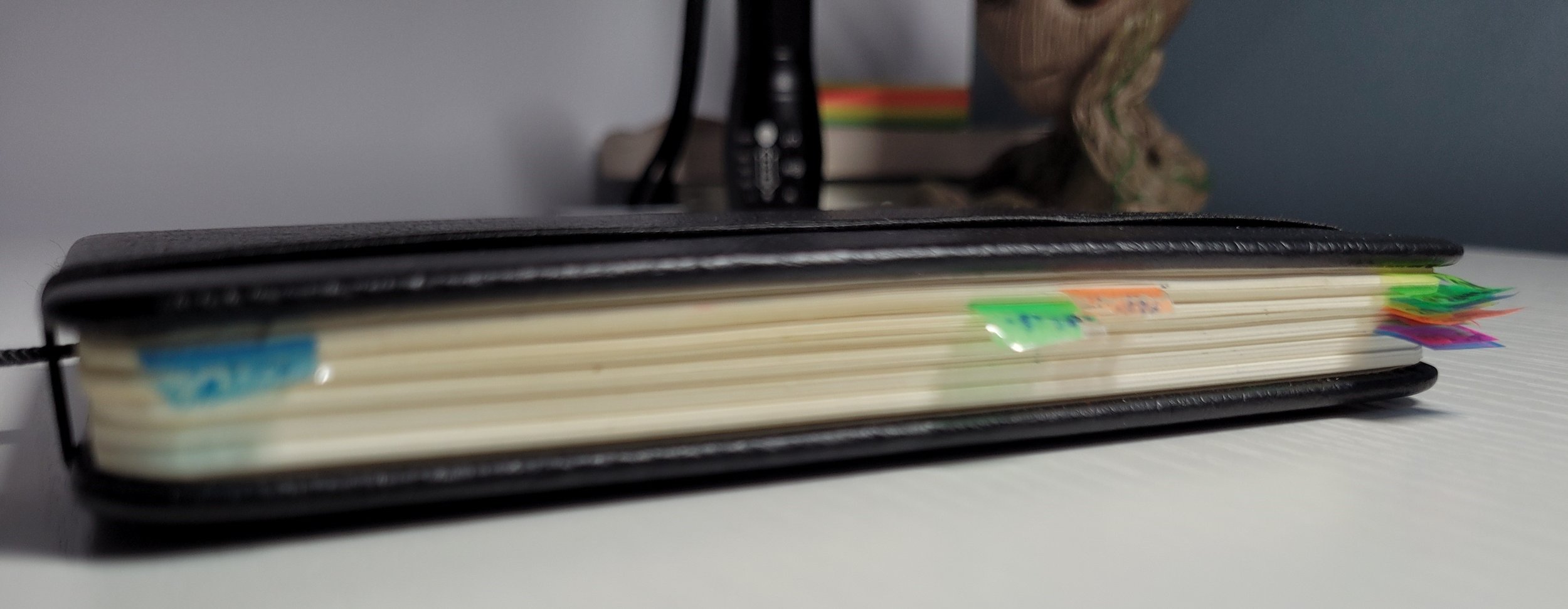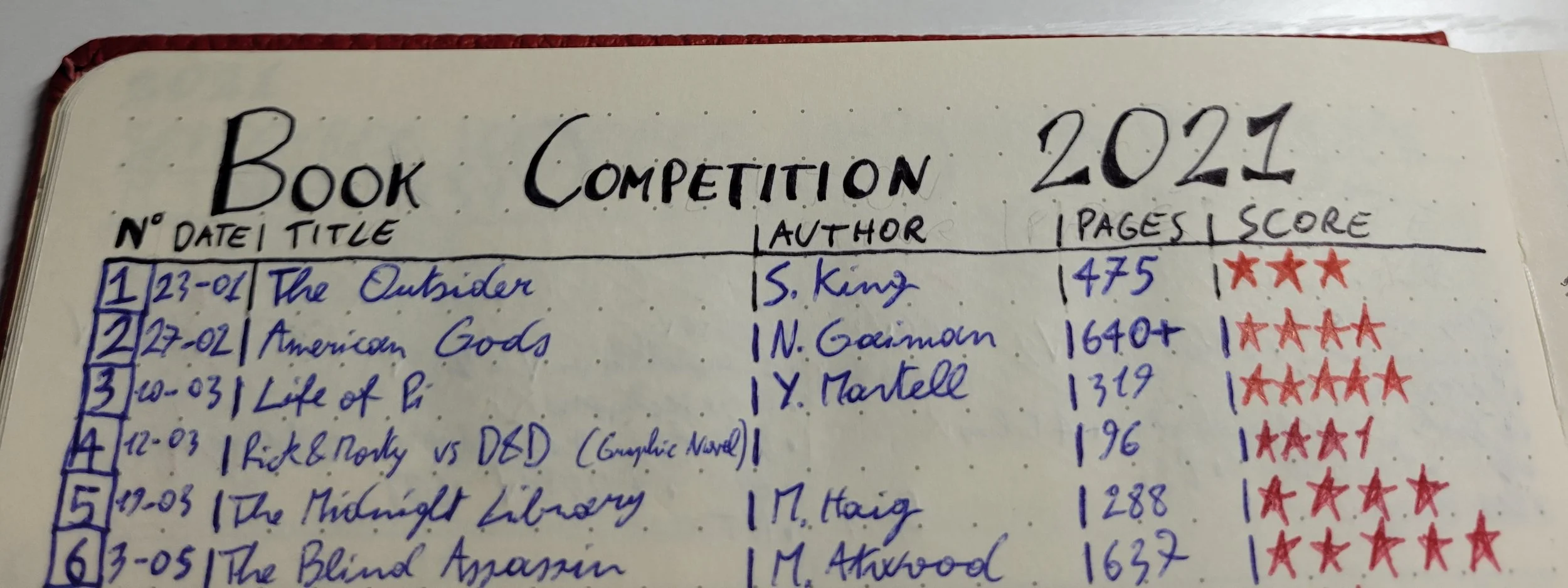How Bullet Journaling Changed My Life
Reading time: 9 min
If you decide to purchase your journal through our affiliate link, we’ll get a few pence in our bank account and you’ll get a big thank you!Photo by Jessica Lewis on Unsplash
When and Why I started
24th of March 2020. This is a date many people will remember in the UK, as this was the first day of our new life.
The first lockdown. So many memories.
I had never worked from home before, and I had to stop listening to the Audiobook of “The Stand,” by Stephen King, because fiction and reality were getting mixed in my mind.
I knew that, as a writer, I was supposed to keep track of what was about to happen—although at the time I thought the pandemic was a matter of weeks, maybe months; nothing more—but I didn’t want to get lost in the crowd of every single writer in the world, locked in their flat, writing about our plague.
On the other hand, I also knew that this was a once in a lifetime chance to get closer to my dream. Unlike many people who’ve been hit hard by Covid-19, I was in a relatively enviable position.
No kids.
A spare room and a stable internet connection (and I had the audacity to complain about not having access to optic fibre. I’m almost as spoiled as Ricky Gervais.)
A 9-5 job, regular salaries and 0 days of furlough.
I can’t lie, I am a spoiled brat, but even I could see I was in a privileged situation, and I was ready to do whatever it took to take advantage of it.
Enter, the Bullet Journal.
What is a Bullet Journal?
This fascinating practice seemed to hit 2 birds with one stone.
It gave me the chance to keep track of the important bits of my life in an orderly and efficient manner while helping me optimise the additional time I had on my hands by means of a simple daily ritual.
“The most overlooked and underappreciated growth strategy is patience.”
An unexpected benefit of filling an actual journal was the renewed connection with the physical world when everything else had moved online. As Cal Newport says in his book Digital Minimalism, human beings are happier when using their dexterity. It doesn’t matter how elegant is a line of code or a spreadsheet; nothing compares to the satisfaction of building something you can touch.
The definition of the Bullet Journal Method, on the official website, is the following:
The Bullet Journal method is a mindfulness practice disguised as a productivity system.
I couldn’t agree more. In simple words, it is a way to translate your life, your entire life, into a bulleted list. And it works. Believe me, it works.
For the very nature of the practice, it also tends to be extremely flexible and customizable, and the number of spreads you can create to accommodate what’s important in your life is essentially endless. If you don’t believe me, have a quick look at these YouTube pages; give me a shout when you re-emerge.
The basic concept is organising the future while remembering the past, and—more importantly—avoiding wasting too much time doing it. The most generalised subdivision on a bullet journal is intuitive: you want a yearly section, a monthly section, a weekly and a—guess what—daily section. Figuring out a legend is also helpful (e.g. a dot for a task, a line for events, a star for commitments, a heart for emotions and so on) and, if like me you’ve got a lot of spreads, maybe an index or a way to easily access the various sections of your journal.
Say hello to baby Groot
My Bullet Journaling Journey
As I said, I started at the end of March 2020 after watching 10 or 15 YouTube videos and buying from Amazon 2 dotted journals (you can use any type of journal, but dotted ones are particularly suitable because they are the perfect compromise between a blank page and a structured one) which I thought were A5 but turned out to be A6. So, my first 9 months have been recorded on this little fellow.
Before diving into the nitty-gritty of what’s in my bullet journal, I want to repeat how soothing it is to create something. I used to love drawing, but with a family, a full-time job, and a passion in an incredibly competitive field that I hope to turn profitable, finding time to sit down and doodle is not among my priorities. Creating and filling those spreads was the closest activity I could find.
Important note: for 2021 and 2022, I reverted to an A5 journal, Dingbats, to be specific. They are sturdy, beautiful and help animals. I chose the red kangaroo for last year and the green stag for this one. Which one would you choose?
The first page
I immediately started by listing out my pre-covid New Year Resolutions.
I believe that looking at your goals every day can have a great impact on achieving or changing them should they lose relevance in your life. Too often we set goals and then forget about them, but then, when we see we have gotten no closer to our dream at the end of the year, the dread becomes real.
“Be radically proactive about any behaviour that pays off in 10 years.”
For 2022, against my own advice, I am not setting any New Year resolution. Having a kid, you can understand, brings a too high degree of uncertainty for me to be comfortable setting any goal at all. Instead, I am setting expectations.
Expect not to sleep.
Expect to be knackered.
Expect your life to be revolutionised.
I also expect to get back to my New Year Resolutions page in 2023, new and updated with goals regarding fatherhood. Wish me luck.
The yearly overview
After the first page, I put up a yearly calendar. Originally, the only purpose of this was to have a quick glance at how many days we would have been in total lockdown, but instead, it became a beautiful way to have an overview of 2020, with important events, holidays and things to look forward to.
The last four months of 2021
The failed experiments
Over the past two years, I tried many spreads and pages that didn’t work out. Among those:
A weekly habits page, right at the end of the calendar, to track things I wanted to do at least once a week. Too messy, I didn’t fill it at all.
A “projects and Ideas” page. This is a modified version of the “brain dump” section that is so well advocated on YouTube. I quickly found out that my brain dump needed to be a journal of its own. I now use the second A6 journal I bought by mistake, and I call it a “Distraction Journal.”
To Be Read list, now on Goodreads and StoryGraph.
Many, many iterations of the weekly and monthly pages.
The spreads to keep
Let’s talk about what did work.
Every year, my wife and I indulge ourselves in a—not so—friendly competition over who reads the most pages. I know this is easily trackable in Goodreads and StoryGraph, but I’ve been recording what I’ve read with an actual pen since 2014 and I don’t want to stop. I also take note of the day I finish the book, the author, the number of pages and the score.
For 2022 I’m expanding this section to also Movies and Series and Audiobooks.
The monthly pages
By far my favourite spread to prepare and fill, every month has its own Habit Tracker divided into 3 sections:
Good Habits, where I fill the square of the days in which I do what I planned to. The squares are small, yes, but not too small to add details, such as letters (Y for yoga in the exercise row) or 2 layers in case I do something twice.
Bad Habits, identified by a red cross, a green tick or, for phone usage, even the amount of time spent in front of the screen for that particular day.
Mood, where I keep track of my mood (black), energy (green), and anxiety.
At the end of each month, it’s super easy to summarise the info and see what I did well and what I have to improve. I even compare each habit to what I’ve done the previous month, to see if I’m following a healthy trend or not.
The second section of the monthly spread has gone through more iteration than the Coca-Cola logo.
Overview, no-overview, goals and reflections, only goals, notes, expenses, etc etc etc.
Through 19 months of doing this, I finally know what I want, at least for now.
Monthly goals don’t work for me. They are too vague, too spread out, so I now have daily goals instead. Also, Monthly reflections are not enough. What I need is just a clear idea of how my month is going to look like and something to look forward to; everything else can be dealt with on a weekly or daily basis.
The weekly pages
It took me almost a year to understand that I wanted a quick snapshot of my week in my bullet journal.
The old version of my writing and reading weekly log. Below this section: pure chaos.
Along my journey, in many shapes and forms, I have constantly kept track of how much I was writing—initially only in hours, as I was mainly doing revisions—and reading, and then I write a few lines for each day as if in a regular, old fashion diary.
The current version of my weekly spread is slightly different from the above and allows me to write down a small, daily to-do list, but I can’t guarantee that it won’t change tomorrow.
Experiments
The beauty of the bullet journal is that you can try any spread that crosses your mind and abandon it if it’s not working for you. This year, for example, I added a couple of pages with affirmations, mantras and more spiritual wishy-washy, just because I felt like it. Fatherhood, right? But I’ve also added a page for sources. I have so many subscriptions, software, blogs, and services that I struggle to remember them. I hope that, with this spread, I’ll be able to use them better when I need them and, at the same time, judge which ones are superfluous.
Conclusion
I know that the title of this article sounds really clickbait, but it’s the truth. Bullet Journaling changed my life. Maybe not as drastically as becoming a parent (we’ll see about that) but subtly, like growing up, a barely noticeable process and yet irreversible.
Without it, big chunks of my lockdown life would have gone forgotten forever, I wouldn’t have been able to step up my writing game, I wouldn’t have read so much, I wouldn’t have noticed my dog was regressing into puppyhood (if it’s a real word), and I wouldn’t have learnt to be gentle with myself, how hard it is for me to readjust after disruptions, how important it is remaining active and how lucky I am to live my life.
If you’re looking for a single habit able to deliver maximum results with minimum effort, I highly suggest you start bullet journaling.
I might even set up a guide if someone is interested.
Alla prossima










